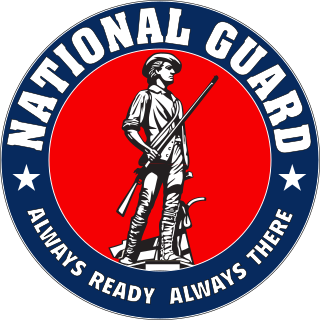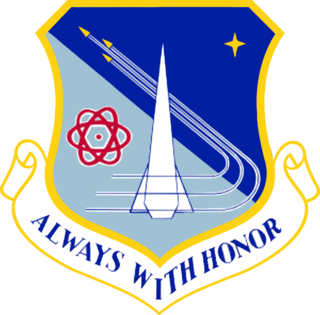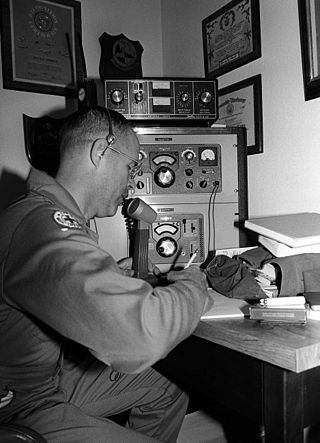History
World War I
The original concept of a non-Regular Army component, existing to augment the standing military, can trace its origins to the United States Volunteers. State volunteer forces were used extensively to augment the Regular Army throughout the 19th and early 20th century. During World War I and dictated by the provisions of the National Defense Act of 1916, states contributed men to the "Volunteer Army" (more commonly known as the National Army). [5] During World War I, a standard practice developed for Regular Army officers to serve in higher positions within the National Army, and thus hold two ranks - a permanent rank and a temporary rank. This concept was related to the idea of the brevet rank, which had generally fallen into disuse by the time of the First World War. The National Army was suspended after World War I.
World War II
In September 1940, the United States reintroduced conscription in response to the increasing likelihood of entry into World War II. Personnel voluntarily enlisting into the United States Army could choose to voluntarily enlist into the Regular Army, National Guard of the United States, or Organized Reserve. On 14 May 1940, legislation provided that all voluntary enlistments in the United States Army during a time of national emergency or war were to be in the Army of the United States "without specification of any particular component or unit thereof." [6] The "Army of the United States" as a service component was formally activated in February 1941. [7] It was legally considered the successor to the National Army.[ citation needed ]
The Army of the United States saw a major expansion following the 7 December 1941 attack on Pearl Harbor. On 13 December 1941, legislation provided that personnel inducted into the United States Army under the terms of the Selective Training and Service Act of 1940 were, both retroactively and from that date on, considered to be serving in the Army of the United States.[ citation needed ]
The first commissioned officers serving in the Army of the United States were appointed from the Regular Army. The standard practice was that these officers held a "permanent rank" within the Regular Army as well as a higher "temporary rank" while serving in the Army of the United States. A typical situation might be a colonel in the AUS holding the permanent rank of captain in the Regular Army. Another term for rank held in the Army of the United States was "theater rank" since the officer was likely to revert to permanent rank if transferred home from the theater of operations. [8]
Promotions within the Army of the United States were sometimes very rapid, and some officers were promoted as many as four to five times in the space of just three to four years. Dwight D. Eisenhower, who served as General of the Army, rose from a colonel to five-star general in three years, holding one-star and two-star ranks for only four months each. However, rank in the AUS could be revoked just as easily, with senior commanders who were relieved reverting to their permanent Regular Army rank. This was known as "loss of theater rank", with some instances of generals returning to the United States in disgrace or at least under a cloud, as only colonels or majors. [9]
Divisions of the Army of the United States
| Division | Date Activated | Campaign Participation Credit |
|---|---|---|
| 11th Airborne Division | 25 February 1943 | New Guinea, Southern Philippines, Luzon |
| 13th Airborne Division | 15 August 1943 | No combat |
| 17th Airborne Division | 15 April 1943 | Ardennes-Alsace, Rhineland, Central Europe |
| 101st Airborne Division | 15 August 1942 | Normandy, Rhineland, Ardennes-Alsace, Central Europe |
| 5th Armored Division | 10 October 1941 | Normandy, Northern France, Rhineland, Central Europe |
| 6th Armored Division | 15 February 1942 | Normandy, Northern France, Rhineland, Ardennes-Alsace, Central Europe |
| 7th Armored Division | 15 February 1942 | Northern France, Rhineland, Ardennes-Alsace, Central Europe |
| 8th Armored Division | 1 April 1942 | Rhineland, Ardennes-Alsace, Central Europe |
| 9th Armored Division | 15 July 1942 | Rhineland, Ardennes-Alsace, Central Europe |
| 10th Armored Division | 15 July 1942 | Rhineland, Ardennes-Alsace, Central Europe |
| 11th Armored Division | 15 August 1942 | Rhineland, Ardennes-Alsace, Central Europe |
| 12th Armored Division | 15 September 1942 | Rhineland, Ardennes-Alsace, Central Europe |
| 13th Armored Division | 15 October 1942 | Rhineland, Central Europe |
| 14th Armored Division | 15 November 1942 | Rhineland, Central Europe |
| 16th Armored Division | 15 July 1943 | Central Europe |
| 20th Armored Division | 15 March 1943 | Central Europe |
| 25th Infantry Division | 1 October 1941 | Central Pacific, Guadalcanal, Northern Solomons, Luzon |
| 42nd Infantry Division | 14 July 1943 | Ardennes-Alsace, Rhineland, Central Europe |
| 63rd Infantry Division | 15 June 1943 | Ardennes-Alsace, Rhineland, Central Europe |
| 65th Infantry Division | 16 August 1943 | Rhineland, Central Europe |
| 66th Infantry Division | 15 April 1943 | Northern France |
| 69th Infantry Division | 15 May 1943 | Rhineland, Central Europe |
| 70th Infantry Division | 15 June 1943 | Rhineland, Central Europe |
| 71st Infantry Division | 15 July 1943 | Rhineland, Central Europe |
| 75th Infantry Division | 15 April 1943 | Rhineland, Ardennes-Alsace, Central Europe |
| 92nd Infantry Division | 15 October 1942 | North Apennines, Po Valley |
| 93rd Infantry Division | 15 May 1942 | New Guinea, Northern Solomons, Bismarck Archipelago |
| 106th Infantry Division | 15 March 1943 | Rhineland, Ardennes-Alsace, Central Europe |
| 10th Mountain Division | 15 July 1943 | North Apennines, Po Valley |
In 1946, with postwar demobilization, the Army of the United States was suspended, along with the draft. Officers from that point reverted to Regular Army rank and all enlisted personnel either were discharged from the Army of the United States and returned to civilian life, or accepted the offer to reenlist in the Regular Army. Units raised in the Army of the United States were deactivated; if the Army chose to activate them again permanently, they were allotted to the Regular Army.
Korean War and Vietnam War
The Army of the United States was demobilized in 1946, but still maintained as a component of the Army. Upon the outbreak of the Korean War, the Army of the United States consisted of conscripts in the Regular Army, with the National Guard and Army of the United States existing simultaneously in the same theater. The system of prefixes before service numbers was as follows:
- ER: Enlisted Reserve
- OR: Officer Reserve
- NG: National Guard
- RA: Regular Army
- US: Army of the United States
The last use of the Army of the United States (AUS) was during the Vietnam War. It was disbanded in 1974.














